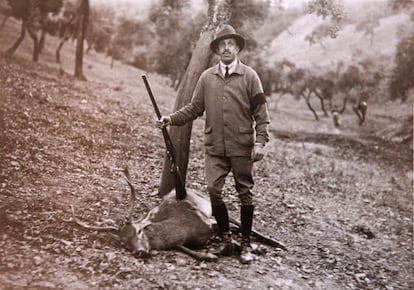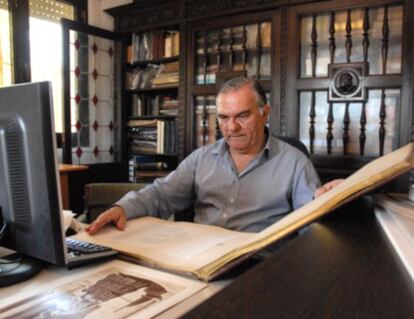A passion for patrimony
A collector from Málaga fears his archive of photography will not end up going on public display

A woman looks at the camera shyly as she hides her face behind a fan. Just one step away, a smartly dressed man touches his hat while he appears to make a flirtatious remark. We know this scene took place on a Córdoba street in the 1870s, and that it was captured by the French photographer Jean Laurent, who was a leading visual chronicler of 19th-century Spain. The shot is just one of 42,000 old photographs lovingly kept by Juan Antonio Fernández Rivero. A passionate collector since childhood, he began with stamps and moved on to old postcards. An amateur photographer, he read The history of photography in Spainby the US Hispanist Lee Fontanella, a book that inspired him to collect old photographs.

Fernández Rivero, an economist by trade who was born in Málaga in 1956, started with old pictures of his home town, which now represent a quarter of the collection; then he expanded to other parts of Andalusia and other areas of Spain before finally going global. His “specialty,” he says, is the 19th century. “Photographs from that era were commercial and documentary in nature, in contrast to what happened in the late 19th century, when photographers began to make art.”
You don’t need to be a millionaire; this isn’t like collecting painting”
Now the author of a dozen books on photography, Fernández Rivero adds that many of the pictures that were taken in 19th-century Spain were snapped in Andalusia “because of the Romantic myth of the Arabic essence that travelers came looking for. The Patio de los Leones in the Alhambra was one of the most-portrayed spots in the world at the time, together with Niagara Falls and Paris,” the city where the first camera had been presented to parliament on June 15, 1839. Other popular draws were Madrid and its outlying areas, Toledo and Barcelona.
Fernández is also “a researcher” who keeps a website where he has uploaded around 10,000 digitalized pictures, and he also maintains a blog to disseminate the work of these pioneers. And all the while, he keeps collecting.
I bought Captain Pilkington’s scrapbook at Christie’s in 1998”
“I am constantly obtaining pieces, always originals. You don’t need to be a millionaire; this isn’t like painting.” With some help from his wife Teresa, Fernández has transferred his catalogue to the outskirts of Málaga. The archive is the result of purchases from London, Paris and New York auctions, as well as merchants, antique dealers and individuals (“many in the US”). He is also a regular at fairs like the one held annually in late May in Bièvres, near Paris. The collection includes 18,000 photographs from the 19th century and 10,000 postcards from the early 20th century. “I also have 9,000 stereoscopic photographs,” he says of the technique of taking two images from different angles, joining them together and viewing them through a visor to see a 3D shot. “The invention was not very successful because soon after that, photography proper came along.”

On top of all that, the collector keeps around 2,500 cartes de visite, small-size portraits that bourgeois people used to hand out to their relatives and friends, to place inside the photo albums that became popular around 1860. The rest of the archive is made up of around 100 daguerreotypes and ambrotypes (positive images on glass); illuminated photographs (with details painted in by hand), Victorian travel journals and illustrated books. All in all, the collection has been described by the photographic historian Publio López Mondéjar as “among the eight to 10 best private photography collections in Spain.”
Fernández himself has a hard time picking out the jewels in the crown of his collection, although eventually he plumps for Captain Pilkington’s scrapbook. “I bought it at Christie’s in 1998 and it contained 30 photographs by Charles Clifford,” he explains. Clifford was the other foreigner, together with Laurent, who made photographic records of Spain under Queen Isabel II. “It is an album measuring 55-75 centimeters, made in the 1850s, with a gilded binding. It contains images that this cultivated Englishman stationed in Gibraltar used to buy at the places he visited; he also pasted in watercolors, drawings, lithographs... 241 items in total.” The collector also treasures the bullfighting collection by the Frenchman Masson, whose shots are part of a scrapbook that belonged to the Duke of Montpensier, brother-in-law to Isabel II. But if he had to choose individual images, Fernández Rivero would keep Portrait of James Linton, a fisherman in New Haven, a calotype (paper coated with silver iodide) from 1845, taken by the Scotsmen Hill and Adamson; he also favors another calotype by the Irishman E. K. Tenison, a Romantic traveler who journeyed across the Iberian peninsula between 1852 and 1854.
“I have tried not to accumulate just for the sake of it,” he says. “Collecting needs to have a meaning, a documentary value, and follow historical criteria. I collect with the notion of someday seeing the collection in a museum.”
So far, however, this wish has found no echo in Fernández Rivero’s city of Málaga, although he has loaned some material out for exhibitions. “I wouldn’t want the collection to go to waste,” he adds, gazing out at Mount Gibralfaro. “This is my life’s work.”
Tu suscripción se está usando en otro dispositivo
¿Quieres añadir otro usuario a tu suscripción?
Si continúas leyendo en este dispositivo, no se podrá leer en el otro.
FlechaTu suscripción se está usando en otro dispositivo y solo puedes acceder a EL PAÍS desde un dispositivo a la vez.
Si quieres compartir tu cuenta, cambia tu suscripción a la modalidad Premium, así podrás añadir otro usuario. Cada uno accederá con su propia cuenta de email, lo que os permitirá personalizar vuestra experiencia en EL PAÍS.
¿Tienes una suscripción de empresa? Accede aquí para contratar más cuentas.
En el caso de no saber quién está usando tu cuenta, te recomendamos cambiar tu contraseña aquí.
Si decides continuar compartiendo tu cuenta, este mensaje se mostrará en tu dispositivo y en el de la otra persona que está usando tu cuenta de forma indefinida, afectando a tu experiencia de lectura. Puedes consultar aquí los términos y condiciones de la suscripción digital.
Últimas noticias
The complicated life of Francesca Albanese: A rising figure in Italy but barred from every bank by Trump’s sanctions
Pinochet’s victims grapple with José Antonio Kast’s rise in Chile
Reinhard Genzel, Nobel laureate in physics: ‘One-minute videos will never give you the truth’
From digital curfews to blocking apps: How technology experts protect their children online
Most viewed
- Why we lost the habit of sleeping in two segments and how that changed our sense of time
- Trump’s obsession with putting his name on everything is unprecedented in the United States
- Charles Dubouloz, mountaineering star, retires at 36 with a farewell tour inspired by Walter Bonatti
- The Florida Keys tourist paradise is besieged by immigration agents: ‘We’ve never seen anything like this’
- Living in a motorhome due to soaring housing prices in Madrid: ‘I got used to it quickly, but I don’t idealize it’









































